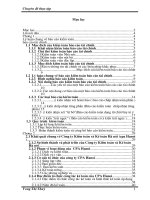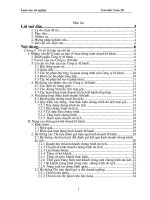Hanoi Opening Mathematical Olympiad
Bạn đang xem bản rút gọn của tài liệu. Xem và tải ngay bản đầy đủ của tài liệu tại đây (144.88 KB, 7 trang )
Hanoi Open Mathematical Competitions 2014
Junior Section
Answers and solutions
Sunday, 23 March 2014 08h30-11h30
Q1. Let the numbers x and y satisfy the conditions
x
2
+ y
2
− xy = 2
x
4
+ y
4
+ x
2
y
2
= 8
The value of P = x
8
+ y
8
+ x
2014
y
2014
is
(A): 46; (B): 48; (C): 50; (D): 52; (E) None of the above.
Answer. (B)
We have
x
2
+ y
2
= 2 + xy.
It follows
x
4
+ y
4
+ 2x
2
y
2
= x
2
y
2
+ 4xy + 4.
Equivalently,
x
4
+ y
4
+ x
2
y
2
= 4(xy + 1),
8 = 4(xy + 1)) ⇔ xy + 1 = 2 ⇔ xy = 1
and then x
4
+ y
4
= 7, xy = 1.
Hence x
8
+ y
8
= (x
4
+ y
4
)
2
− 2x
2
y
2
= 49 − 2 = 47 and we find P = 47 + 1 = 48.
Q2. How many diagonals does 11-sided convex polygon have?
(A): 43; (B): 44; (C): 45; (D): 46; (E) None of the above.
Answer. (B)
The number of diagonals of 11-sided convex polynom is difined by
11(11 − 1)
2
− 11 = 44.
Q3. How many zeros are there in the last digits of the following number
P = 11 × 12 × · · · × 88 × 89
(A): 16; (B): 17; (C): 18; (D): 19; (E) None of the above.
1
Answer. (C)
We have
P = 5
18
· A,
where A is the integer containing sufficiently many even factors. Thus, the answer is 18.
Q4. If p is a prime number such that there exist positive integers a and b such that
1
p
=
1
a
2
+
1
b
2
,
then p is
(A): 3; (B): 5; (C): 11; (D): 7; (E) None of the above.
Answer. (E) Write m := (a, b). It implies
a = mr
b = ms.
We then have
1
p
=
1
m
2
r
2
+
1
m
2
s
2
.
It follows
p(r
2
+ s
2
) = mr
2
s
2
.
Since r
2
+ s
2
is not divisable by neither r
2
nor s
2
, we have p
.
.
.r
2
and p
.
.
.s
2
. As p is a prime
number, r
2
= s
2
= 1. We find m = 2 and p = 2. So, the answer is (E).
Q5. The first two terms of a sequence are 2 and 3. Each next term thereafter is the sum
of the nearestly previous two terms if their sum is not greather than 10, 0 otherwise. The
2014th term is
(A): 0; (B): 8; (C): 6; (D): 4; (E) None of the above.
Answer. (B)
We have the sequence as follows
2, 3, 5, 8, 0, 8, 8, 0, 8, 8, . . .
Starting from the fifth term, the sequence is periodic with the period 3. We then have
a
n
=
0, if n − 4 = 1 (mod 3)
8, otherwise.
Note that 2014 − 4 = 2010 = 0 (mod 3). Thus, the answer is 8.
2
Q6. Let a, b, c be the length sides of a given triangle and x, y, z be the sides length of
bisectrices, respectively. Prove the following inequality
1
x
+
1
y
+
1
z
>
1
a
+
1
b
+
1
c
.
Solution.
Let AD be bisector of angle BAC and D belongs to BC. Draw DE AB, E belongs
to AC. Then triangle EAD is iscoceles and DE = EA = d. We have
ED
AB
=
EC
CA
and
then
AE
AC
+
ED
AB
=
EC
CA
+
AE
CA
= 1. It follows
d
b
+
d
c
= 1 ⇔
1
b
+
1
c
=
1
d
. Hence
1
2
1
b
+
1
c
=
1
2d
<
1
x
(1) since 2d > AD.
Similarly,
1
2
1
c
+
1
a
<
1
y
, (2)
1
2
1
c
+
1
a
<
1
y
. (3)
From (1), (2) and (3) we find
1
x
+
1
y
+
1
z
>
1
a
+
1
b
+
1
c
,
which was to be proved.
Q7. Determine the integral part of A, where
A =
1
672
+
1
673
+ · · · +
1
2014
.
Solution. Consider the sum
S =
3n+1
k=n+1
1
k
.
Note that there are 2n + 1 terms in the sum and the middle term is
1
2n + 1
. So we can
write the sum in the form
S =
1
2n + 1
+
n
k=1
1
2n + 1 + k
+
1
2n + 1 − k
3
=
1
2n + 1
+
2
2n + 1
n
k=1
1
1 −
k
2n + 1
2
.
On the other hand, using the inequalities
1 + a <
1
1 − a
< 1 + 2a for 0 < a <
1
2
,
we get
1
1 −
k
2n + 1
2
> 1 +
k
2n + 1
2
and
1
1 −
k
2n + 1
2
< 1 + 2
k
2n + 1
2
.
Hence
1
2n + 1
+
2
2n + 1
n
k=1
1 +
k
2n + 1
2
< S <
1
2n + 1
+
2
2n + 1
n
k=1
1 + 2
k
2n + 1
2
⇔ 1 +
2
(2n + 1)
3
n
k=1
k
2
< S < 1 +
4
(2n + 1)
3
n
k=1
k
2
⇔ 1 +
n(n + 1)
3(2n + 1)
2
< S < 1 +
2
3
n(n + 1)
(2n + 1)
2
.
It is easy to check that
2
9
≤
n(n + 1)
(2n + 1)
2
<
1
4
, ∀n ≥ 1.
This leads to
29
27
< S <
7
6
and then [S] = 1 and [A] = 1.
Q8. Let ABC be a triangle. Let D, E be the points out side of the triangle so that
AD = AB, AC = AE and ∠DAB = ∠EAC = 90
◦
. Let F be at the same side of the line
BC as A so that F B = F C and ∠BF C = 90
◦
. Prove that triangle DEF is a right-isoceles
triangle.
Solution.
Note that CD ⊥ BE and ∆F EB = ∆F DC. Hence, F E = F D. (1).
On the other hand, ∠DF C = ∠EF B then ∠DF E = 90
0
. (1)
(1) and (2) together imply |deltaDEF | is right-iscoceles, q.e.d.
Q9. Determine all real numbers a, b, c such that the polynomial f(x) = ax
2
+ bx + c
satisfies simultaneously the folloving conditions
|f(x)| ≤ 1 for |x| ≤ 1
f(x) ≥ 7 for x ≥ 2
4
Figure 1:
Solution. Let g(x) = 2x
2
− 1 − f(x), then deg g ≤ 2. Note that
g(−1) = 1 − f(−1) ≥ 0, g(0) = −1 − f(0) ≤ 0, g(1) = 1 − f (1) ≥ 0
and g(2) = 7 − f (2) ≤ 7 − 7 = 0. Hence the equation g(x) = 0 has at least 3 roots. It
follows g(x) ≡ 0 and then f (x) = 2x
2
− 1.
Thus (a, b, c) = (2, 0, −1).
Q10. Let S be area of the given parallelogram ABCD and the points E, F belong to BC
and AD, respectively, such that BC = 3CE, 3AD = 2AF. Let O be the intersection of
AE and BF. The straightlines AE and BF meet CD at points M and N, respectively.
Determine area of triangle MON.
Solution.
Let a = AB and h be the height of the parallelogram. Since ∆EAB ∼ ∆EMC,
it follows
CM
AB
=
EC
EB
=
1
2
and CM =
a
2
. Similarly, we have N D = a, then M N =
a + a +
a
2
=
5a
2
.
Let h, h
1
, h
2
be heights of the given parallelogram, ∆OM N and ∆OAB, respectively,
then
h
1
h
2
=
MN
AB
=
5
2
.
5
It follows
h
1
h
=
h
1
h
1
+ h
2
=
5
7
.
Hence h
1
=
5h
7
. These follow that
S
M ON
=
1
2
× MN × h
1
=
1
2
×
5a
2
×
5h
7
=
25ah
28
=
25
28
S.
Q11. Find all pairs of integers (x, y) satisfying the following equality
8x
2
y
2
+ x
2
+ y
2
= 10xy.
Solution. We have 8x
2
y
2
+ x
2
+ y
2
= 10xy ⇔ 8xy (xy − 1) + (x − y)
2
= 0. (1)
Consequently, if x; y is an integral root of the equation then xy (xy − 1) ≤ 0 ⇒ 0 ≤
xy ≤ 1.
Because x; y are integral, there are two possibilities:
- If xy = 0 then from (1) we have a root x = y = 0.
- If xy = 1 then from (1) we have other roots x = y = 1; x = y = −1.
Thus the equation has three solutions (x, y) = (0, 0), (x, y) = (1, 1), (x, y) = (−1, −1).
Q12. Find a polynomial Q(x) such that (2x
2
− 6x + 5)Q(x) is a polynomial with all
positive coefficients.
Solution. Note that
(2x
2
− 6x + 5)(2x
2
+ 6x + 5)(4x
4
+ 6x
2
+ 25) = 16x
8
+ 164x
4
+ 625.
Hence
(2x
2
−6x+5)(2x
2
+6x+5)(4x
4
+6x
2
+25)(x
3
+x
2
+x+1) = (16x
8
+164x
4
+625)(x
3
+x
2
+x+1)
= 16x
11
+16x
10
+16x
9
+16x
8
+164x
7
+164x
6
+164x
5
+164x
4
+625x
3
+625x
2
+625x+625.
So we can choose Q(x) = (2x
2
+ 6x + 5)(4x
4
+ 6x
2
+ 25)(x
3
+ x
2
+ x + 1).
Q13. Let a, b, c > 0 and abc = 1. Prove that
a − 1
c
+
c − 1
b
+
b − 1
a
≥ 0.
Solution. We prove the following inequality
a
c
+
c
b
+
b
a
≥ ab + bc + ca. (1)
6
Indeed, from inequality (c − 1)
2
(2c + 1) ≥ 0 for c > 0, it follows
2c
3
+ 1 ≥ 3c
2
⇔
1
c
+ 2c
2
≥ 3c ⇔ ab + 2c
2
≥ 3abc
2
⇔
a
c
+
2c
b
≥ 3ac.
Similarly,
c
b
+
2b
a
≥ 3bc,
b
a
+
2a
c
≥ 3ab.
These three inequalities imply
a
c
+
c
b
+
b
a
≥ ab + bc + ca =
1
c
+
1
a
+
1
b
.
Hence
a
c
+
c
b
+
b
a
≥
1
c
+
1
a
+
1
b
,
which is
a − 1
c
+
c − 1
b
+
b − 1
a
≥ 0.
The equality holds iff a = b = c = 1.
Q14. Let be given a < b < c and f (x) =
c(x − a)(x − b)
(c − a)(c − b)
+
a(x − b)(x − c)
(a − b)(a − c)
+
b(x − c)(x − a)
(b − c)(b − a)
.
Determine f(2014)?
Solution. Let g(x) = f(x) − x. Then deg g ≤ 2 and g(a) = g(b) = g(c) = 0. Hence
g(x) ≡ 0 and f(x) = x for all x ∈ R. It follows f(2014) = 2014.
Q15. Let a
1
, a
2
, . . . , a
9
≥ −1 and a
3
1
+ a
3
2
+ · · · + a
3
9
= 0. Determine the maximal value of
M = a
1
+ a
2
+ · · · + a
9
.
Solution.
For a ≥ −1, we find (a + 1)
a −
1
2
2
≥ 0. It follows
a
3
−
3
4
a +
1
4
≥ 0 ⇔ 3a ≤ 4a
3
+ 1, ∀a ≥ −1.
Hence
3(a
1
+ a
2
+ · · · + a
9
) ≤ 4(a
3
1
+ a
3
2
+ · · · + a
3
9
) + 9 = 9.
So M ≤ 3. The equality holds for a
1
, a
2
, . . . , a
9
∈
− 1,
1
2
. For example, we can choose
a
1
= −1, a
2
= a
3
= · · · = a
9
=
1
2
, then a
3
1
+ a
3
2
+ · · · + a
3
9
= 0 and a
1
+ a
2
+ · · · + a
9
= 3.
Thus, max M = 3.
—————————————–
7





